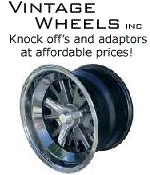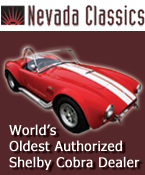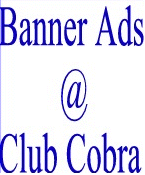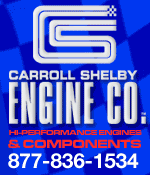 
 Main Menu
Main Menu
|
 Nevada Classics
Nevada Classics
|
 Advertise at CC
Advertise at CC
|
 January 2025
January 2025
|
| S |
M |
T |
W |
T |
F |
S |
| |
|
|
1 |
2 |
3 |
4 |
| 5 |
6 |
7 |
8 |
9 |
10 |
11 |
| 12 |
13 |
14 |
15 |
16 |
17 |
18 |
| 19 |
20 |
21 |
22 |
23 |
24 |
25 |
| 26 |
27 |
28 |
29 |
30 |
31 |
|
|
 CC Advertisers
CC Advertisers
|
|

12-08-2001, 12:38 AM
|
 |
CC Member

|
|
|
Join Date: Sep 2001
Location: Danville,
CA
Cobra Make, Engine: CSX 6079 482CI CSX cross ram
Posts: 1,354
|
|

 Not Ranked
Not Ranked
 what size carbs??
what size carbs??
I am building a 428 FE with a FOMOCO 2X4 med. riser intake with a fairly mild cam. Peter at ERA recomends Holley 450's and I am considering Holley 0-9776 (4160 style) no choke & vacume secondaries.
Can any one give me some advise. I am hearing different things from different people and I need some guidence!
Thanks,
Mike    |
-
Advertising


12-08-2001, 02:51 AM
|
|
CC Member

|
|
|
Join Date: Mar 1999
Location: Albuquerque, New Mexico USA 87112,
Posts: 9
|
|

 Not Ranked
Not Ranked
 Carbs on a FE
Carbs on a FE
I have built numerous 427-512 cubic inch FE's with dual quads. My favorate is the 450 CFM Holley. It's the least expensive and always seems to run very well. No bogs!!!! Darrell
|

12-08-2001, 11:29 AM
|
 |
CC Member

|
|
|
Join Date: Sep 2001
Location: Danville,
CA
Cobra Make, Engine: CSX 6079 482CI CSX cross ram
Posts: 1,354
|
|

 Not Ranked
Not Ranked
Darrell,
Holley makes a matching set 0-80431 & 0-80432 they are made for 2X4 applications they are also 550cfm what do you think about these... Also what part # 450,s are you reffering too?
(0-9776)?
Mike
|

12-08-2001, 11:53 AM
|
|
CC Member

|
|
|
Join Date: Mar 1999
Location: Albuquerque, New Mexico USA 87112,
Posts: 9
|
|

 Not Ranked
Not Ranked
 Carbs on a FE
Carbs on a FE
MrMike, I don't have access to my Holley book at this moment but I think the 550's are really designed for drag racing and maybe even be a center squirter that opens all the barrels at one time. If this is so then you definately do not want it for your cobra, unless all you do is drag racing. Also you need to check because on most of the front to rear 2x4 intakes you need a carb without a secondary metering BLOCK. The carbs with a METERING BLOCK are too long. ie they don't fit the manifold.
The 450's have a METERING PLATE, NOT BLOCK, ie thinner, that fits inside the float bowl.
The 450's # 0-9776 have a metering plate. The other thing you need to understand is that you don't need anything bigger than the 450's. 900 CFM on a 428 is gobs for the street. The smaller barrels on the 450's increase velocity and driveability.
Gotta go now, I'll look up the 550's asap.
Darrell
|

12-08-2001, 12:55 PM
|
|
CC Member

|
|
|
Join Date: Jun 2000
Location: Redding,Ct.,
ct
Cobra Make, Engine: Unique S/C with 428
Posts: 56
|
|

 Not Ranked
Not Ranked
mrmike,
I have a pair of #9776 450's on my 428 powered Shelby and they work like a champ. I changed the main jets to #60's otherwise they worked right out of the box. Even the cold starting is good (no chokes on these carbs). And $175.00 each from Summit or Jegs they are a steal.
|

12-08-2001, 02:12 PM
|
 |
CC Member

|
|
|
Join Date: Sep 2001
Location: Danville,
CA
Cobra Make, Engine: CSX 6079 482CI CSX cross ram
Posts: 1,354
|
|

 Not Ranked
Not Ranked
Sounds like the holley #0-9776 is the way to go.. However the holley 0-80431 & 0-80432 is a reproduction of the original but holley does not make them anymore. I am trying to find them someware if I can not then I will look real hard at the 0-9776. Any jetting info would be helpfull on the 0-9776
Thanks,
Mike  |

12-08-2001, 07:37 PM
|
|
CC Member

|
|
|
Join Date: Aug 1999
Location: Englewood, CO,
Posts: 41
|
|

 Not Ranked
Not Ranked
 Original Holley/Ford 2-4V carbs and Air flow
Original Holley/Ford 2-4V carbs and Air flow
MrMike, the Holley carbs you refer to were a re-issue of the factory Ford 2-4V carbs used by Ford on 2-4V 427's and 428's from 1963 to 1967. They are vac secondary, have the front metering block and secondary plate, correct side lever design for the dual quad linkage, correct vac diaphram covers for dual fours, and are calibrated for dual four use on the street. Remember, Ford sold these on new cars, to the public. They had to perform very well, with out causing warrenty problems. They were specifically designed and calibrated by Holley for good overall street performance.
One thing very few people understand, is that carburetor air flow is rated differently. For example, a 500cfm 2V carb only flows 333cfm when rated the same way a 4V carb is rated-1.5" vs. 3" of mercury. Similarly, multi-carb set-ups do not flow what the sum of the carbs would indicate. Ford new this when designing all of their mutli-carb set-ups in the sixties. Obviously, a stock 427 or 428 engine with 1100cfm would seem to be overcarbureted. But it works very well, and Ford put even bigger pairs of carbs-652, 715, and 780cfm-on the hotter engines. An indicated 1100 cfm works as if it is really closer to 750-850 cfm. Likewise, the dual 450's at 900cfm total act like a 650-750 cfm carb. So one is not really as "overcarbureted" as one would beleive with 2-4V set ups. What often happens though, is folks bolt on a pair of 1850's, without more than a jet change, and then unfairly blame the 2-4V set up overall when running into driveability problems. Dual quad carbs were calibrated for the application.
But, as you know, original Ford 2-4V carbs are hard to find, and when located have 30+ years of wear. They typically need extensive restoration work on top of their initial price. Holley actually discontinued the 80431/32's a number of years ago, even though they were in the catalog.
On the 2-4V's we set up for our customers, we have been either custom modifying the generic 450 and 600 Holley's, restoring original carbs, or using some re-issue C3AE-9510-BJ/BK (550cfm) carbs that Holley made for us a few years ago. They are basically the 80431/32's, but with factory Ford numbers. They work great, look "original", and have all of the correct linkage attachments, etc. So there are a number of carburetor choices when setting up a 2-4V, depending upon the individuals preferences. If you really prefer the factory BJ/BK Holley's, drop me a line, as I have a few sets left.

|

12-08-2001, 07:57 PM
|
 |
CC Member

|
|
|
Join Date: Sep 2001
Location: Danville,
CA
Cobra Make, Engine: CSX 6079 482CI CSX cross ram
Posts: 1,354
|
|

 Not Ranked
Not Ranked
Rob,
Please contact me direct!!!! mlagrone@pacbell.net or 650.222.5838
Thanks!
mike |

12-09-2001, 03:35 AM
|
|
CC Member

|
|
|
Join Date: Mar 1999
Location: Albuquerque, New Mexico USA 87112,
Posts: 9
|
|

 Not Ranked
Not Ranked
 Carbs on a FE
Carbs on a FE
Mr.mike and Rob, First I would like to preface this comment regarding due respect to all involved. Having said this my original comments were to express my experience in carb selection on dual quad setups for cobras. Let me state a few things.
1. What relevance does the flow rating on a 2v vs 4v have in this situation? Both carbs are rated on a different pressure drop but this just seems to confuse the issue.
2. I think it is pretty common knowledge that it is possible to use a larger vacuum secondary carb than a mechanical secondary one. This is due mostly to the fact that the engine air flow will govern when the secondaries open, not allowing the traditional bog or lack of response often associated with mechanical secondary carbs when open at too low of an RPM.
3. It is my opinion, which has been backed up by numerous articles over the years that all of the major manufacturers over carbuerated their High Performance engined cars in the 60's. The primary reason was NHRA rules which goverened drag racing in certain classes. Winning on Sunday sold cars on Monday. The manufacturers got away with the larger carbs by using vacuum secondary carbs for the street and allowed the stock class drag cars to fully utilize their potential. Remember that the drag racers go way past the RPM that a street car does.
4. Any serious drag racer will use a larger carb than would normally be used on a street car. Driveability is not a problem at the strip. They are looking for every last horsepower. A pressure drop of even 1.5" is too much. More correctly a serious drag racer would calculate his engine carb size by utilizing something near .5" pressure drop. Thusly you need a much larger carb.
5. My comments and recommendations were based upon a rather fool proof, inexpensive carb recommendation. The 450's are very streetable and require little tuning. Their small venturi size promotes excellent throttle response and driveability.
6. If your looking strictly for the exact LOOK of the original then the 450's are not the ticket. ie no vacuum secondary.
Now after pissing off half of the world I appoligize. Just trying to help. Darrell

|

12-09-2001, 10:11 AM
|
 |
CC Member

|
|
|
Join Date: Sep 2001
Location: Danville,
CA
Cobra Make, Engine: CSX 6079 482CI CSX cross ram
Posts: 1,354
|
|

 Not Ranked
Not Ranked
Darrell,
I am a little confused... You state that the 450's have no vacume secondaries? Holly #9776 ? Summit mag says that they do...   |

12-09-2001, 10:34 AM
|
|
CC Member

|
|
|
Join Date: Mar 1999
Location: Albuquerque, New Mexico USA 87112,
Posts: 9
|
|

 Not Ranked
Not Ranked
 Carbs on a FE
Carbs on a FE
MrMike, I looked in the summit catalog. They have it screwed up. #09776 does not have vacuum secondaries. The picture is wrong. It has a mechanical linkeage that begins to open the secondaries at about 2/3 to 3/4 throttle. Primary side only metering BLOCK and accel pump. Look in the Jeg's catalog or online maybe at Jeg's. Sorry for the confusion but Summit needs to get it straight. Darrell
|

12-09-2001, 03:27 PM
|
|
CC Member

|
|
|
Join Date: Jun 2000
Location: Redding,Ct.,
ct
Cobra Make, Engine: Unique S/C with 428
Posts: 56
|
|

 Not Ranked
Not Ranked
mrmike,
As I stated earlier my 67 GT500 has a pair of #9776 450's on it. The oiginal BJ & BK carbs are in a box . Why ? because those $175 450's with mechanical secondaries make the car an absolute pleasure to drive. It has excellent throttle response , no flat spots and reasonable fuel consumption if you don't hammer it to badly.
|

12-09-2001, 04:46 PM
|
 |
CC Member

|
|
|
Join Date: Sep 2001
Location: Danville,
CA
Cobra Make, Engine: CSX 6079 482CI CSX cross ram
Posts: 1,354
|
|

 Not Ranked
Not Ranked
Peter,
Want to sell the BJ & BK's??
Mike
|

12-09-2001, 05:55 PM
|
|
CC Member

|
|
|
Join Date: Aug 1999
Location: Englewood, CO,
Posts: 41
|
|

 Not Ranked
Not Ranked
 Carbs on FE
Carbs on FE
Darrell, Who would you have pissed off? You are offering your good advice/experience/observations. True, the 2V to 4V flow comparison may have muddied the water a bit, but I was just trying to show that carb air flow ratings cannot be taken so literally. I often hear milti-carb set-ups (2-3V and 2-4V) harshly put down as being impossible to drive and keep tuned, way over carbed, etc., misleading opinions that are often based on little experience. As you and many others can attest, multi-carburated engines can be just as fun and easy to drive as single carb ones. It's old, worn out carbs or ones that have had too many "tuners", that tend to foster the bad reputations.
True, some times the factories over carbed their engines, but not as often a folks think. The small block Ford Tri-power flows a mere 520cfm, rated in 4V flow. The FE 3-2V flows about 730cfm. The 390GT was given a 600 Holley, and the 428CJ a 735-which has always been a superb carb. Ford made sure that their carb selections actually matched the street driven vehicle very well-with a few exceptions: notably the over carbed Boss 302 with a 780, and the undercarbed Boss 429 with a 735. I have never specifically seen a different way of "rating" dual four air flow, but I have seen references to it in old Ford engineering literature. It's also interesting to watch 2-4V vacuum secondaries on the dyno. Dyno air flow usage is showing barely 600cfm, and the secondaries are already open.
Now, if you look at a hot 2-4V equipped FE with both the small carbs and a pair of the 715's or 780's designated for drag use, it will likely run slightly faster in the quarter with the big carbs, but not near as well on the street. Similarly, I have a hard time comprehending the 2500 and 2900 cfm total flow of the dual Autolite inline carbs Ford had for racing.
One can also use the 390cfm vac secondary carbs for 2-4V applications. There are numerous choices that can be made to work in different applications. Each has their good points.

|

12-09-2001, 06:01 PM
|
|
CC Member

|
|
|
Join Date: Jun 2000
Location: Redding,Ct.,
ct
Cobra Make, Engine: Unique S/C with 428
Posts: 56
|
|

 Not Ranked
Not Ranked
mrmike,
As they are the original carbs they would go with the car if I ever sold it. They were restored and rebuilt by Holley prior to being stored on a shelf. So no they are not for sale.
The whole point here is that unless you have an original dual quad car that used these carbs they are not worth owning . You will never beat a mechanical secondary carb for responsiveness. You can go spend a lot of money and find yourself a pair of BJ/BK carbs for your Cobra but I promise you that while they may look original the 450's will run better......So are you going to look at it or drive it ??????
|

12-10-2001, 02:02 PM
|
 |
CC Member

|
|
|
Join Date: Jul 1999
Location: Prescott Valley,
AZ
Cobra Make, Engine: Previous ERA owner on break
Posts: 600
|
|

 Not Ranked
Not Ranked

mrmike:
FWIW, I've got two 600 cfm vacuum secondary Holley model (P/N 0-1850) on my 484 stroker. The 1850s are sort of the "generic" Holley 600 cfm unit which is used for a number of applications. I removed the chokes completely, have reduced the main jets from the stock #66 to #62. I am planning to reduce further to #60 as it is still running slightly rich, so my personal experience matches Pete Wolff's. I also replaced the vacuum springs with the heaviest ones Holley offers to clear up a bog during acceleration. The car starts with only a couple of pumps of the gas pedal regardless of the temperature. This also worked while I was living in Pennsylvania; during the winter, I would drive the car down to about 40 degrees as long as the roads were clear, and never had a problem starting it. It idles reasonably smoothly at 900 rpm and drives well through the rpm range.
I agree with Darrell in his points. The mechanical secondary versions will give better throttle response assuming the carbs are tuned correctly for the engine. This will entail either some time on a dyno or a bit of "trial and error" tuning to get the appropriate combination of metering jets, power valves and diaphragm springs. Also, the carbs with the metering block (model 4150) will usually not fit on the FE dual-quad manifolds as they are too long.
However, I do have a further question for Darrell or Rob. I understood from one of the Holley reps at a past meet that the 4160 series could not be converted to mechanical secondaries because they lacked a secondary-side accelerator pump. According to him, opening the mechanical secondaries without compensating for the temporary lean condition would result in major bog-down, and that's why Holley didn't sell conversion kits for the linkages. How does the 0-9776 get by with mechanical linkage and no secondary accelerator pump? Inquiring minds want to know.
__________________
Some folks drink from the fountain of knowledge; others just gargle.
Yesterday's flower children are today's blooming idiots.
|

12-10-2001, 03:04 PM
|
|
CC Member

|
|
|
Join Date: Jun 2000
Location: Redding,Ct.,
ct
Cobra Make, Engine: Unique S/C with 428
Posts: 56
|
|

 Not Ranked
Not Ranked
Chopper
Thee way that the 450's get away without a second accelerator pump is because of thier small venturi size. This generates an extremely strong signal which enables the carbs to transition from idle to main circuit without an additional pump shot .
|

12-10-2001, 07:01 PM
|
|
CC Member

|
|
|
Join Date: Mar 1999
Location: Albuquerque, New Mexico USA 87112,
Posts: 9
|
|

 Not Ranked
Not Ranked
 NO BOGG
NO BOGG
Chopper, I agree with Pete. The 450's have very small venturi bores, which are really crowded by the booster venturis. This results in a high velocity air flow and a very strong signal to iniate the flow of fuel to the secondaries. I think it also helps because the primaries are opened 2/3 of the way before the secondaries open. Engine RPM is higher. I haven't checked it but it is possible that the accelerator pumps have a very slow opening and long duration which could overlap into the opening of the secondaries. Of course this would not mix immediately with the air in the secondaries but would probably help by the time the air gets into the cylinder.
Another interesting thing is the dual plane design of the Ford 2 x4 intake. Each barrel of the carb has a short and long path to take. The short path to a cylinder under the carb and a longer path to a different cylinder. If I remember correctly when all 8 barrels are open each cylinder can pull air from 4 different barrels, 1 primary on the front carb, 1 secondary on the front carb, 1 primary on the rear carb and 1 secondary on the rear carb. You really have to look at the manifold without any carbs on it and try to follow the air flow path.
One word of caution, Some of the Holley tech guys are not that sharp. Most are, but I have found a few that were really confused.

|

12-10-2001, 11:38 PM
|
|
CC Member

|
|
|
Join Date: Aug 1999
Location: Englewood, CO,
Posts: 41
|
|

 Not Ranked
Not Ranked

The Holley tech guys aren't that sharp?? Gee, and I thought they were just being difficult. Actually, when Holley got bought out a few years ago, they let 75% of their staff go. And guess what, the older, experienced guys that really knew carbs were some of the first. Holley is "Going in a new direction" and needed new, younger personell that are more familiar with fuel injection and what not. Most of 'em now don't even know what an emulsion tube is.
Chopper, the 1850's are as you say, a "generic" carb with "universal" calibration. For your 2-4V application, you need to reduce the power curcut by about 40-50%, and keep the jetting where it is to reduce the over-rich condition. The 1850's metering blocks are not very sophisticated in their set-up, but that will be an easy first step.
With the heavy secondary springs, are the carbs even opening during acceleration? We usually work with accelerator pump volume&timing, power valves, linkage adjustment, float setting, and moderate springs to adjust for "bog".
We have used the 450 vacuum secondary carbs on very mild engines, but not the double pumpers. Have any of you that are using the double pumper 450 carbs on hotter engines ever monitored engine vacuum at WOT at higher rpm's? I would be really interested in what you have for engine vacuum at say 5000-6500rpm.

|

12-11-2001, 07:31 AM
|
 |
CC Member

|
|
|
Join Date: Jul 2000
Location: Amherst, MA, USA,
Posts: 149
|
|

 Not Ranked
Not Ranked
Darrell:
Did you ever find out any more info on the 550's? I'm interested in that I have a matched set of P/N #1849 which I believe are 550's. I really haven't looked hard but the 3 Holley books I have do not reference the 1849s. They are not center-squirters and from what I can tell (and this is visual reference only) they are identical to 1850s, just with a smaller base bore.
Thanks!
__________________
Jimbo
|
 Posting Rules
Posting Rules
|
You may not post new threads
You may not post replies
You may not post attachments
You may not edit your posts
HTML code is Off
|
|
|
All times are GMT -7. The time now is 08:14 PM.
|






















 Linear Mode
Linear Mode



